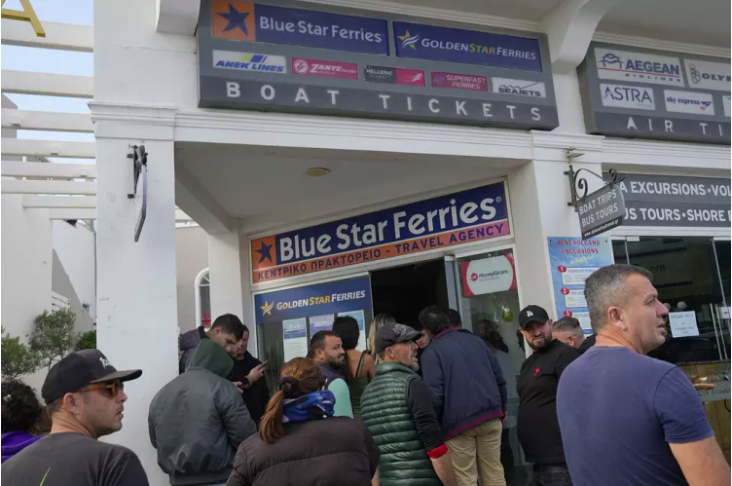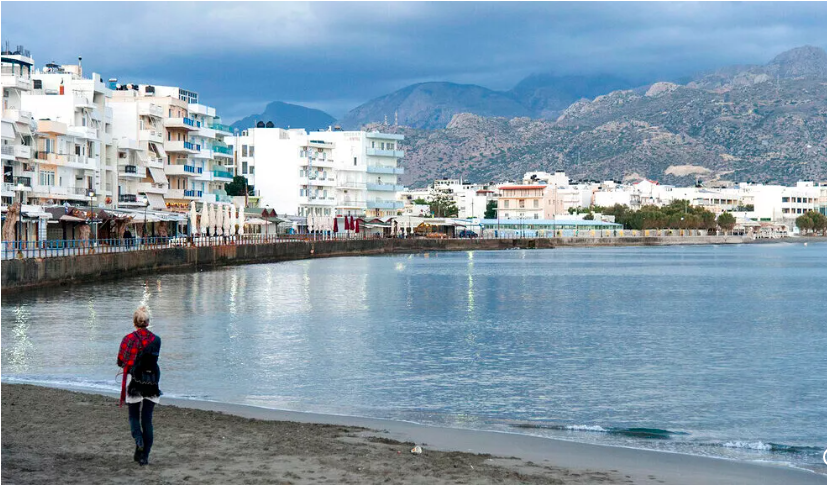Recent Earthquakes Near Crete and Santorini Prompt Tourist Safety Warnings but Don’t Panic
Quote from Alex bobby on May 23, 2025, 5:33 AM
Tremors in Paradise: Earthquakes Near Crete and Santorini Spark Tourist Safety Warnings
In the span of just two weeks, two powerful earthquakes have shaken the Greek island of Crete and the surrounding Aegean islands, stirring concern among locals and tourists alike. A 6.1-magnitude quake struck off the coast of Crete on Thursday, following a similar undersea tremor just over a week prior that was felt as far as Egypt. Though there has been damage reported in parts of Crete’s historic port and temporary tsunami warnings were issued, experts are urging calm while encouraging visitors to stay informed and prepared.
Crete Earthquake Prompts Tsunami Alert
The most recent earthquake, which occurred beneath the seabed near Crete, led to a brief tsunami warning and caused structural damage to buildings in the port area. While no casualties have been reported, the seismic activity has led authorities and experts to remind tourists of the region’s inherent geological risks. Greece sits on the boundary of the African and Eurasian tectonic plates, making it one of Europe’s most earthquake-prone regions.
Despite the quake’s strength, Rémy Bossu, Secretary-General of the European-Mediterranean Seismological Centre, downplayed any unusual risk. “Every time you go to Greece, you are going to a seismically active region,” he told Euronews. “The hazards are not significantly higher than they were yesterday, or in February.”
Unusual Activity in Santorini
In February, the island of Santorini experienced a different kind of seismic event: an “earthquake swarm,” a series of near-constant tremors that led to a state of emergency. Unlike the single, stronger events of Crete, these swarms often suggest underlying volcanic activity. Santorini, being a volcanic island, has historically seen such occurrences, but the recent swarm prompted thousands of tourists and locals to evacuate temporarily.
Dr. Nikolaos Melis, a seismologist and Director of Research at the Institute of Geodynamics in Athens, noted the volcanic link to the Santorini activity. However, he also reassured the public that while alarming, the swarm does not currently indicate an impending volcanic eruption. “Researchers have no reason to believe that Greece will experience a devastatingly large earthquake anytime soon,” Melis told Euronews.
Safety Guidance for Tourists
As peak travel season approaches, tourists heading to Crete, Santorini, or other Aegean islands are advised to familiarise themselves with basic earthquake safety. “The most likely cause of injuries is falling objects if you are inside. So you have to protect yourself by going below a table and avoiding open areas when possible,” Bossu explained. Outdoor dangers also exist—tiles, balconies, and other structural elements can become hazardous in a quake.
Though a tsunami warning was issued following the 6.1-magnitude quake, experts clarify that such alerts are automatic in the Mediterranean when an undersea earthquake exceeds magnitude 6. For quakes of this scale, the actual tsunami risk is low. “You do not expect a large tsunami,” said Bossu. “The advice is to avoid harbours and beaches temporarily, as changes in sea level or whirlpools can occur.”
Greek Preparedness and Infrastructure
Greece, and particularly its islands, have long been at the forefront of seismic preparedness. With a strong national building code and modern engineering practices, most infrastructure in tourist areas is designed to withstand moderate to strong quakes. “Greece has got the highest seismic activity in Europe and next to Turkey we have two countries with very high activity,” said Dr. Melis. “But as I said, the catastrophic magnitudes are very rare.”
While the visuals and aftershocks can be unsettling—residents on Crete described hearing a “loud roar” after the quake—the actual risk of harm is relatively low for those who follow safety procedures and stay informed.
What Tourists Should Do
Tourists planning to visit the Greek islands should:
- Read up on local emergency protocols before traveling.
- Know where emergency exits and safe spots (e.g., under sturdy furniture) are located.
- Follow official instructions during and after tremors.
- Avoid beaches and ports immediately following strong undersea quakes.
- Remain calm and informed through reliable news sources or local authorities.
Conclusion
While the recent earthquakes in Crete and Santorini have sparked concern, they are part of the geological reality of this beautiful and historically rich region. The tremors serve as a reminder, not of panic, but of the importance of preparedness. Greece’s seismic activity is well-documented, and infrastructure is built to cope with it. For tourists, awareness and adherence to safety guidance are key to enjoying a safe and memorable trip to the Aegean islands.

Tremors in Paradise: Earthquakes Near Crete and Santorini Spark Tourist Safety Warnings
In the span of just two weeks, two powerful earthquakes have shaken the Greek island of Crete and the surrounding Aegean islands, stirring concern among locals and tourists alike. A 6.1-magnitude quake struck off the coast of Crete on Thursday, following a similar undersea tremor just over a week prior that was felt as far as Egypt. Though there has been damage reported in parts of Crete’s historic port and temporary tsunami warnings were issued, experts are urging calm while encouraging visitors to stay informed and prepared.
Crete Earthquake Prompts Tsunami Alert
Register for Tekedia Mini-MBA edition 17 (June 9 – Sept 6, 2025) today for early bird discounts. Do annual for access to Blucera.com.
Tekedia AI in Business Masterclass opens registrations.
Join Tekedia Capital Syndicate and co-invest in great global startups.
Register to become a better CEO or Director with Tekedia CEO & Director Program.
The most recent earthquake, which occurred beneath the seabed near Crete, led to a brief tsunami warning and caused structural damage to buildings in the port area. While no casualties have been reported, the seismic activity has led authorities and experts to remind tourists of the region’s inherent geological risks. Greece sits on the boundary of the African and Eurasian tectonic plates, making it one of Europe’s most earthquake-prone regions.
Despite the quake’s strength, Rémy Bossu, Secretary-General of the European-Mediterranean Seismological Centre, downplayed any unusual risk. “Every time you go to Greece, you are going to a seismically active region,” he told Euronews. “The hazards are not significantly higher than they were yesterday, or in February.”
Unusual Activity in Santorini
In February, the island of Santorini experienced a different kind of seismic event: an “earthquake swarm,” a series of near-constant tremors that led to a state of emergency. Unlike the single, stronger events of Crete, these swarms often suggest underlying volcanic activity. Santorini, being a volcanic island, has historically seen such occurrences, but the recent swarm prompted thousands of tourists and locals to evacuate temporarily.

Dr. Nikolaos Melis, a seismologist and Director of Research at the Institute of Geodynamics in Athens, noted the volcanic link to the Santorini activity. However, he also reassured the public that while alarming, the swarm does not currently indicate an impending volcanic eruption. “Researchers have no reason to believe that Greece will experience a devastatingly large earthquake anytime soon,” Melis told Euronews.
Safety Guidance for Tourists
As peak travel season approaches, tourists heading to Crete, Santorini, or other Aegean islands are advised to familiarise themselves with basic earthquake safety. “The most likely cause of injuries is falling objects if you are inside. So you have to protect yourself by going below a table and avoiding open areas when possible,” Bossu explained. Outdoor dangers also exist—tiles, balconies, and other structural elements can become hazardous in a quake.
Though a tsunami warning was issued following the 6.1-magnitude quake, experts clarify that such alerts are automatic in the Mediterranean when an undersea earthquake exceeds magnitude 6. For quakes of this scale, the actual tsunami risk is low. “You do not expect a large tsunami,” said Bossu. “The advice is to avoid harbours and beaches temporarily, as changes in sea level or whirlpools can occur.”
Greek Preparedness and Infrastructure
Greece, and particularly its islands, have long been at the forefront of seismic preparedness. With a strong national building code and modern engineering practices, most infrastructure in tourist areas is designed to withstand moderate to strong quakes. “Greece has got the highest seismic activity in Europe and next to Turkey we have two countries with very high activity,” said Dr. Melis. “But as I said, the catastrophic magnitudes are very rare.”
While the visuals and aftershocks can be unsettling—residents on Crete described hearing a “loud roar” after the quake—the actual risk of harm is relatively low for those who follow safety procedures and stay informed.
What Tourists Should Do
Tourists planning to visit the Greek islands should:
- Read up on local emergency protocols before traveling.
- Know where emergency exits and safe spots (e.g., under sturdy furniture) are located.
- Follow official instructions during and after tremors.
- Avoid beaches and ports immediately following strong undersea quakes.
- Remain calm and informed through reliable news sources or local authorities.
Conclusion
While the recent earthquakes in Crete and Santorini have sparked concern, they are part of the geological reality of this beautiful and historically rich region. The tremors serve as a reminder, not of panic, but of the importance of preparedness. Greece’s seismic activity is well-documented, and infrastructure is built to cope with it. For tourists, awareness and adherence to safety guidance are key to enjoying a safe and memorable trip to the Aegean islands.
Uploaded files:


